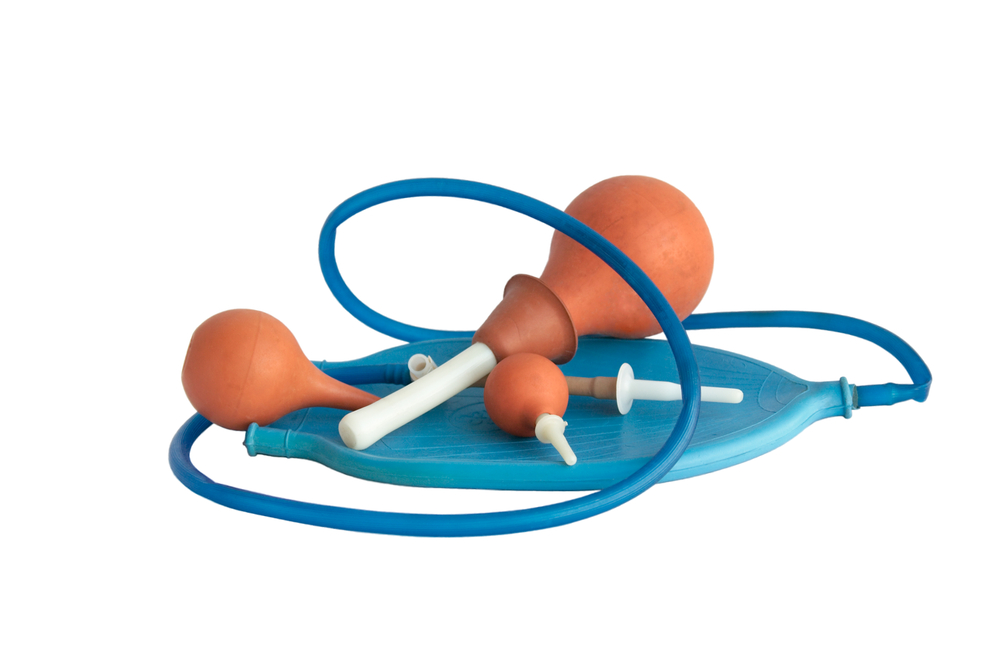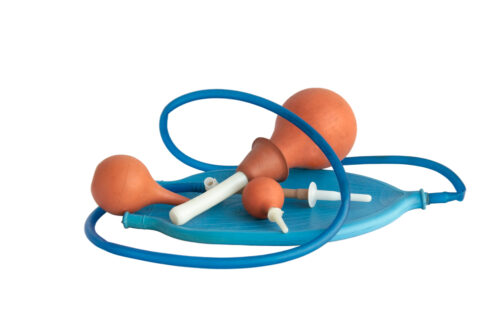Enemas: A Natural Health Tool or Cause for Concern?


After seeing private 1-on-1 clients for a few years, I was consistently shocked at how many constipated clients reported things like, “I use 1 or 2 enemas a week because the constipation is so bad.”
Everytime I heard this it made me cringe. I knew that these people were doing their best to poop as often as they could, which in my opinion is better than being constipated. But they likely had no idea how dangerous enema usage for chronic constipation can be.
In the alternative health world enemas seem to get a free pass. But I doubt so many people would use them if they knew about the following concerns.
As you’ll soon learn, I’m not suggesting that very occasional (not monthly) usage of enemas is bad.
I think that when used as suggested by doctors for colonoscopy prep and to avoid further complications that can come from constipation, such as toxic megacolon, impacted stools or hemorrhoids, they can be a wonderful tool.
A Seemingly Harmless Tool for Constipation
Enemas are often a go-to for people experiencing chronic constipation.These seemingly harmless constipation fixes are available over-the-counter in different forms:
- Sodium phosphate (referred to as saline)
- Bisacodyl
- Oil based
Each of these types of enemas achieve their laxative effects via different pathways.
The Interesting Ways Enemas Work
Interestingly enough, enemas don’t just flush water in there to help you get the poop out. They work in some very novel ways.
Fleet is a common over-the-counter enema sold as a “saline enema” that uses the active ingredient sodium phosphate to get you unstuck. It acts primarily by drawing water into the colon, which loosens stools and increases gut motility. These enemas are associated with some pretty big risks that we’ll dive into more in a bit.
Studies suggest Bisacodyl enemas work directly on the tissue of your colon. They aggravate the cells into increased secretion and motility of the muscles. They also appear to draw water into the colon.
Oil based enemas are often the go-to for hard stools.They act by softening stuck stools through lubrication from the oil and softening of the stool. However, they do have the undesirable side effect of possible anal leakage after use.
Each type primarily tries to soften and encourage the body to get rid of the stool. However, they can lead to things like leakage and “consta-rrhea” – an idea that Chris Kresser talks about where you have diarrhea but not full evacuation and still end up feeling constipated.
Enemas, Cause for Concern?
We’ve talked before about the problems that can arise from laxative use for chronic constipation. Turns out some of the same problems apply to the use of enemas. They can be broken down into the following three issues:
- Electrolyte Disturbance
- Dependency
- Gut Flora Disruption
None of these issues are good to have on a regular basis. Enemas, used for short-term interventions, such as a colonoscopy prep, are not the big issue here. However, please read about the Fleet electrolyte issues below as these can be very dangerous.
- Enemas Affect Your Electrolyte Balance
If you are dealing with any known electrolyte imbalances it’s a very bad idea to use a phosphate enema. These are typically sold as Fleet Saline Enemas. Diarrhea in general will deplete electrolytes, however phosphate enemas seem to be worse than normal.
A case report in a research article reported an elderly man who experienced kidney damage following administration of sodium phosphate enemas.The other bit that should be mentioned are some of the risks associated with phosphate enemas like Fleet. One study puts it this way:
“Phosphate enemas should be used with caution in patients with impaired renal dysfunction, pre-existing electrolyte imbalances, risk of electrolyte disturbance (hypocalcemia, hyperphosphatemia or hypernatremia) or a serious adverse event secondary to one of the above, dehydration, chronic inflammatory bowel disease, gastric bypass or stapling surgery (177).”
Though these cases are rare they are still worth mentioning and certainly worth considering if you are thinking of using a sodium phosphate enema.
- Enema Dependency is Real
Our bodies are amazing at adjusting to habits and routines. Think about travelling across time zones. It takes our brains and hormones a few days to adjust, but after about a week we are right on schedule.
The same thing can happen with using the bathroom. Our bodies like schedules and routines. If you use an enema every few months there’s not a new schedule. But using one weekly is something that your brain and intestines begin to count on. Your muscles will begin adapting to a new way of life and it’s not natural. Our bodies were designed to remove the waste by themselves.
I’ve talked to more than a few people who are unfortunately caught in this enema usage cycle. And the whole time they are disrupting their gut flora and electrolytes.
Mental and physical dependence on enemas can and does happen. It’s something to be aware of. Certainly there are many other ways to get rid of the constipation.
- Your Gut Flora Doesn’t Want You to do Enemas
Your gut flora is extremely important for health. Diseases of the GI tract are almost always found with gut microbiota alterations known as gut dysbiosis. A study that used laxatives to induce diarrhea in healthy people found, “significant relative shifts in the phylas Bacteroidetes and Firmicutes and to a relative increase in the abundance of Proteobacteria on the mucosa, a phenomenon also noted in several inflammatory and diarrheal GI diseases.”
It goes on to summarize, “Changes in microbial community structure induced by osmotic diarrhea are profound and show similarities to changes observed in other GI diseases including IBD.”
What does this have to do with enemas? Well, many times enema usage leads to osmotic diarrhea, which is exactly what is happening in these studies. Furthermore, a study on colonoscopy preparation showed short-term changes in gut flora post procedure.
Another similar study concluded that there were definite changes in microbial gut flora after colonic procedures. These studies focused on the bowel preparation for colonoscopies which vary but often include the use of enemas and laxatives that flush your bowels.
This act of flushing the gut changed the gut flora short term. So, the infrequent usage of these laxatives isn’t something to get too freaked out by. However, regular usage seems to be a very bad idea.
Alternatives to Enemas for Constipation
So, let’s say you’re a bit concerned about enema usage like I am. What is a constipated person to do?
In my opinion, there are safer and natural alternatives to ease the pain and start going again.
I’ve developed a whole constipation protocol that those who own our Solving Leaky Gut program are using with amazing success. And now it’s time to give it to you in greater detail.
Check out our 2.5-Hour Constipation Event to learn safe short- and long-term strategies to beat constipation. In these materials, I’ll guide you through non-toxic, non-habit forming ways to start pooping on a daily basis. More importantly, we dove into the root causes of constipation that are typically the real reason behind the bloating and pain.
Learn more here: http://constipationhelp.scdlifestyle.com
I’ve struggled on and off with constipation throughout my life. And I know based on all my client experience, that regardless of mild to extreme constipation, the whole problem is much more complex than modern medicine wants to admit.
The great thing is, once you find the root cause of your constipation and rebuild your body it won’t ever be a problem again. I’ll show you how in this three step system proven to reduce, eliminate, and even reverse chronic constipation—without prescription drugs.
-Steve
Did You Like this Article?
Subscribe to our newsletter to receive email notifications, some ways to find relief, and next steps.
